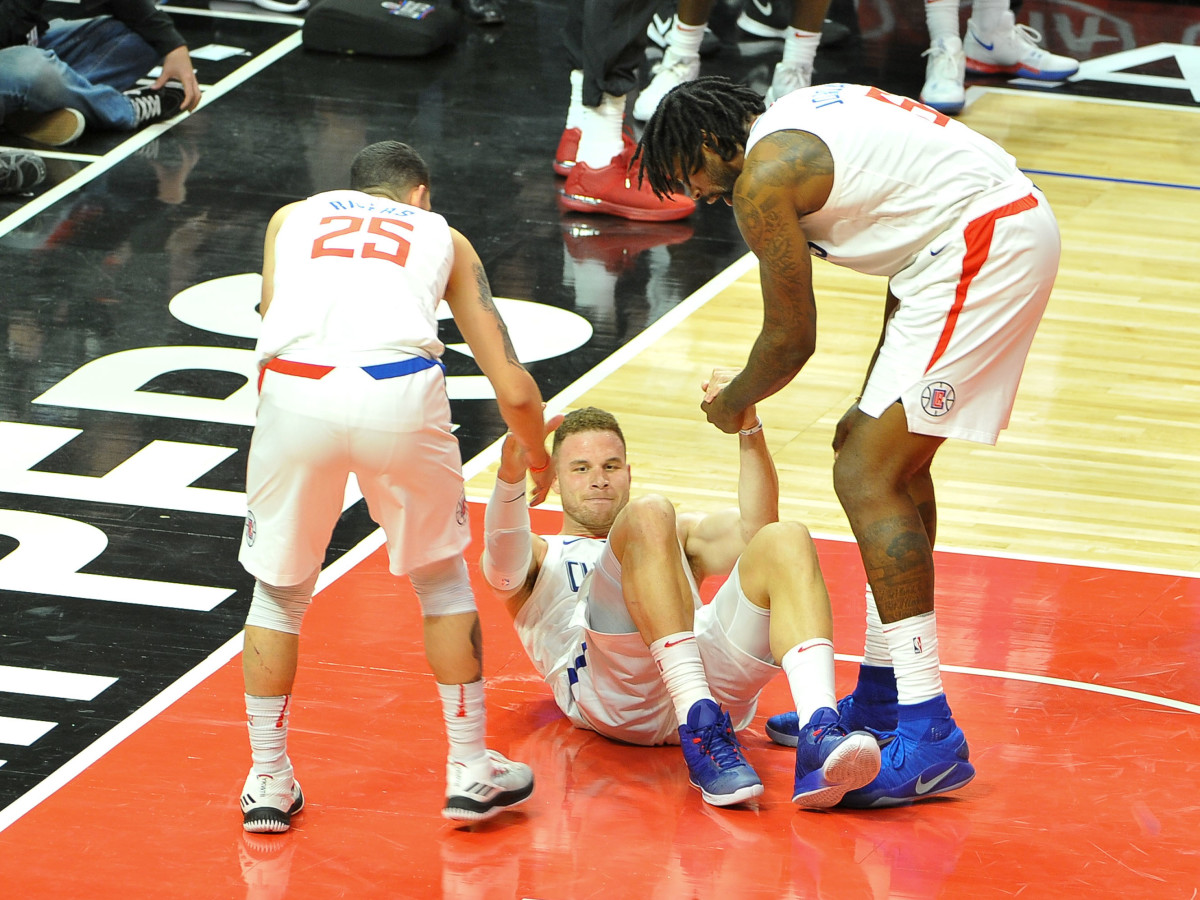The Clippers Are Cooked without Blake Griffin

On Monday night, the Los Angeles Clippers notched their third straight win but may have lost their season to collateral damage. The circumstances behind it were innocent enough: Lakers guard Lonzo Ball ran a fourth-quarter pick-and-roll into the heart of the Clipper defense, but saw it stunted when Wesley Johnson stretched in to poke away his dribble. Ball went to the floor and his defender, Austin Rivers, appeared to trip over the dogpile directly into Blake Griffin's left knee. The injury was so obvious and so clearly painful that a diagnosis with a two month timetable (officially an MCL sprain) drew relief from Clippers officials. It could have been so much worse.
Then again, the damage is already done. Griffin could wind up missing somewhere in the neighborhood of 25 games—enough to all but end any hopes the 8-11 Clippers have of making the playoffs. Patrick Beverley is already out for the season after undergoing microfracture surgery on his right knee. Danilo Gallinari has missed three weeks with a strained glute, an injury concerning enough that Clippers coach Doc Rivers insists Gallinari will not return to the lineup "until he's right." Miloš Teodosić, who went down in the second game of the season with a plantar fascia injury, isn't expected back until after Christmas. With Griffin, that puts the Clippers out four starters, enough to severely compromise the rotation of the team and devastate the concepts it relies on.
Staggering Clippers Hold Their Breath After Blake Griffin Injures Knee
The roster itself was conceived with Griffin in mind. It was his unique brand of playmaking that made it conceivable for the Clippers to part ways with Chris Paul via trade in the first place, in large part due to the viability of different breeds of point guard. If the ball could be in Griffin's hands even more, then the limitations of guards like Beverley and Lou Williams would be far less pronounced. A certain type of player could be reframed by the Clippers' changing circumstances.
That allowed L.A. to pursue Gallinari rather than a more expensive replacement at the point, solely on the condition that the multitalented All-Star could help fill the void. Now the void threatens to swallow the team whole; there is nowhere near enough playmaking left to muster a competent offense, nor the depth required to improve upon the Clippers' subpar defense. For as long as Griffin is out, the Clippers are cooked.

What remains is a staggeringly weak playing rotation without any organizational chemistry. Take away Griffin and the lead guards and Austin Rivers might actually see his 38% shooting from the field take a nosedive. Deny them real creators and players like Wesley Johnson and Sam Dekker (now an essential fill-in) lose function. Even DeAndre Jordan, the Clippers' best available player, has precious little to do now that his support system has been stripped away. Only six Clippers have even assisted Jordan this season—Griffin most of anyone. Three of those six are now out of the lineup entirely.
Who can even take on the 25 possessions per game that Griffin so capably consumed? Jordan is one of the best players in the league for whom added usage is a genuine burden. A team cannot arbitrarily get him more touches because of how little Jordan can do with the ball in his hands. He is the endpoint—an incredible finisher, but one wholly reliant on the creation of others. The gradual disintegration of the lineup will make him more reliant on offensive rebounds than ever. Fortunately for Jordan, the Clippers figure to miss gobs and gobs of shots.
With Griffin down, there's blood in the water. The Clippers had actually done an admirable job previously of surviving finite stretches without Griffin on the floor, but that entire dynamic shifts when opponents know he'll be out of the mix entirely. An underqualified reserve will be made a starter, alongside other underqualified reserves made starters. The fate of the season could hinge on the players the Clippers once deliberately buried within their depth chart.
The Case For: Giving Lonzo Ball a Break
All of which is to say: The Clippers owe themselves a hard, honest look. There has never been greater cause to trade Jordan, a possibility the front office has toyed with for years. Jordan has the option to enter free agency next summer if he so chooses, but there is a market nonetheless for what's left of his current contract. A number of teams on the cusp could do well with a few months of Jordan's rim protection and rebounding, all while positioning themselves well for his potential free agency by acquiring his Bird rights. The potential for a trade is there, but so, too, is the ticking clock.
Sketch out what the rotation will look like for the next few months. Consider what good Griffin's return could even do if his absence goes as expected. A team this reliant on so many highly conditional players isn't suited to adapt to these circumstances; it's suited to cringe through long, hopeless possessions for months on end, only to pray that Griffin and Gallinari—two of the more injury-prone stars in the league—don't go down again.
Misfortune has presented the Clippers an opportunity. All they really have left—considering all that they've already lost—is a dwindling window to take it.
